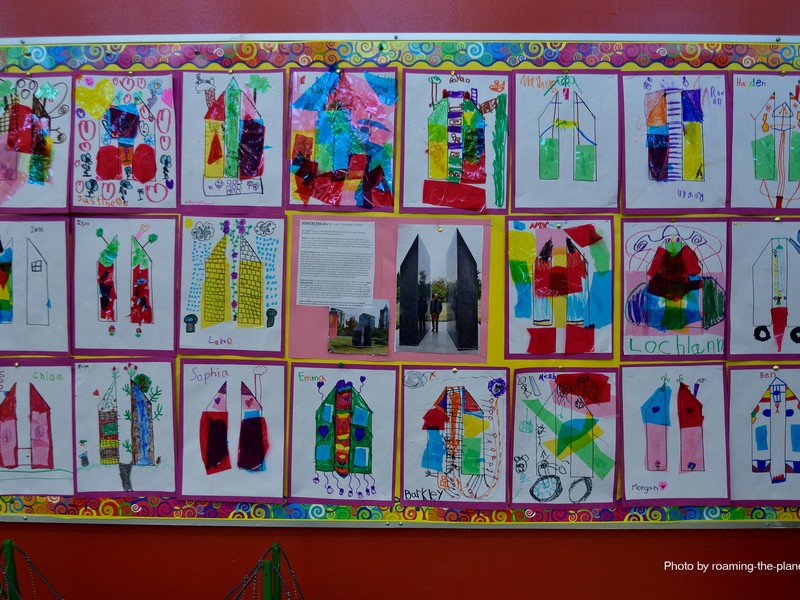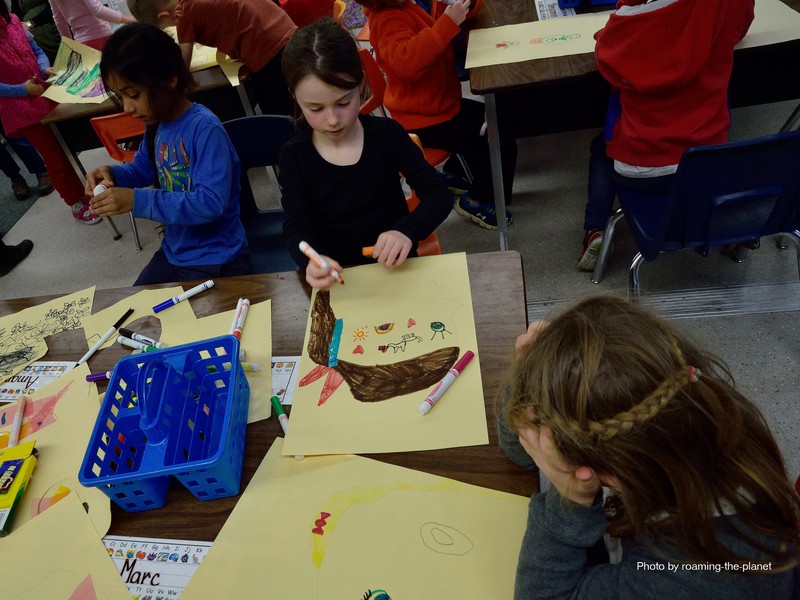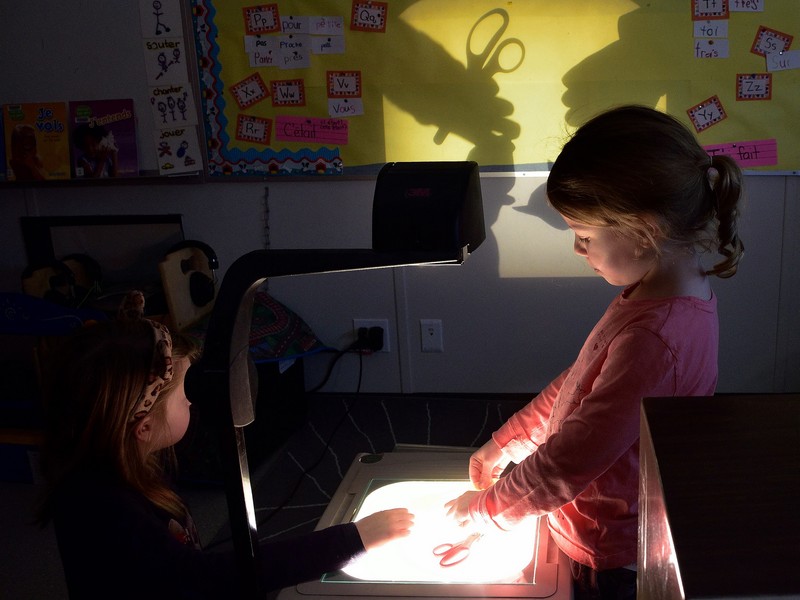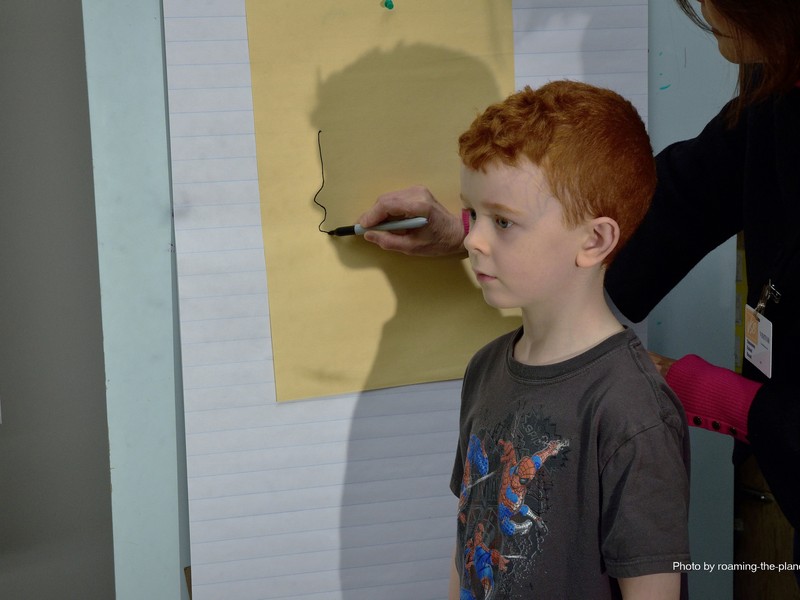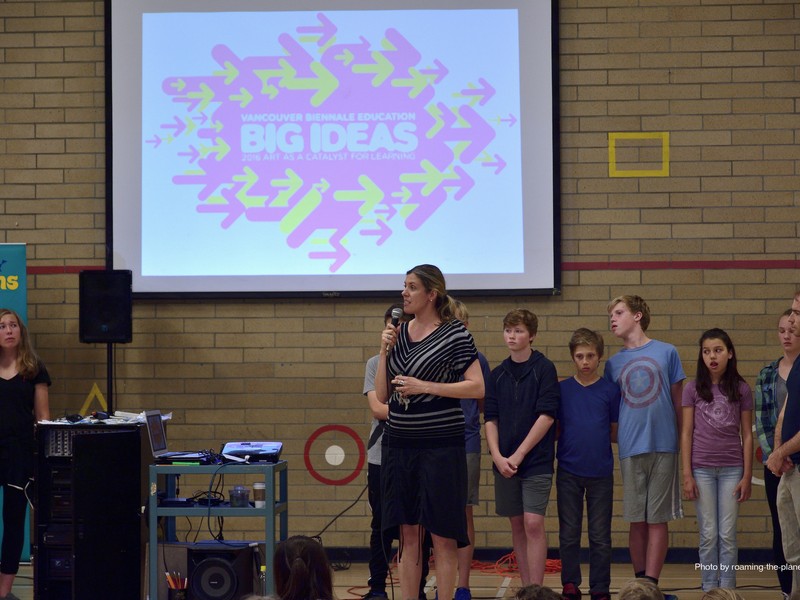École Bilingue (Grade 1): Our Natural and Human Made World
Arts Education, Health and Career Education, Language Arts, Science, Social Studies
School: Ecole Bilingue Elementary
Teacher: Gabriela Novotny
Artist Collaborators: École Bilingue (Grade 1): Our Natural and Human Made World
Class: Grade 1
Overview
This project was about experiencing natural and human-made aspects of our environment to help foster greater appreciation for nature. The final project integrated their collaborative inquiry learning in social studies, science, language arts, dance and music to create a musical piece in French with a special focus on sounds and light which had been explored with Biennale BIG IDEAS Artist Amy- Claire Huestis. The class also worked together with their L’Ecole Bilingue Grade 7 class (led by classroom teacher Oli Salvas) which was working on a project of their own connected to the same installation.
Connection to the Vancouver Biennale Exhibition
The class visited two installations at the beginning of April. The first one (and the one most directly connected to the project) was Home by the Sea, by Luis Fernando Pelaez. With this installation, the students explored one human-made object that is common to them (a house). The purpose of this installation was to explore materials that something is made from and how it impacts their enjoyment and its functionality. Does it shield them from the elements? Is it comfortable? Why would something be made from that material? The class also explored other ‘houses’ in the area (ie: bird’s nests) and looked at these structures through the various lenses that these questions offered and become more connected to the guiding question. This installation was also a focus point of discussion between Mr. Oli’s Grade seven class and this grade-one class. Upon returning to the classroom, students altered a simple image of the installation to use their imagination and new-found knowledge about light, and at the same time, make a personal exploration of what they had viewed on the field trip.
The second installation visited was F-Grass by Ai Wei Wei. The teachers introduced this installation by asking how and why it was made? The class explored how it looked like natural grass and how it was different because it was not like natural grass. Upon returning from the installation, the students looked at an image and analyzed the spacing of the ‘grass blades’ and discussed how it would be different if they were not spaced so evenly. The class explored how every blade was important to the whole, just like every person is important to the whole of the group…just as every individual will be important for the whole of this project.
The students then tried to reproduce this spacing in their own individual art project with the letter of their name. The teacher utilized art as a catalyst for learning both as a point of group discussion as well as a way of making abstract ideas more concrete and tangible (to promote understanding and mind-opening).
BIG IDEAS
The value of this project is that it was not simply revolving around only answering what is natural and what are human-made things. As the class moved between and interconnected one curricular content area with another with various hands on and/or critical thinking activities, students built their own personal understanding of the BIG IDEA which was: All natural and human-made things around us impact our community and our environment. The hope is that in doing this project that students, and the school community, were able to come away with a greater appreciation for nature/earth (which is the source of all things).
Guiding Questions
In what ways do all natural and human-made things around us impact our community and our environment?
Cross-Curricular Access
Social Studies: We shape the local environment, and the local environment shapes who we are and how we live.
Science (Light and Sound): Students studied how natural and artificial light could be produced and how properties can be changed.
Science (Properties of Matter): Matter is useful because of its properties. (ie: how a house changes in usefulness if it is made from metal compared to if it is made from wood).
Language Arts:
This area of the curriculum was the medium from which students created perspectives and was the springboard for the song. Strategies and processes included reading strategies, oral language strategies, metacognitive strategies, and writing processes. Students planned and created a variety of communication forms for different purposes and audiences.
Physical and Health Education: Explore relationships between food, hydration, and health (discovering how food is made from it’s various natural and more human-made sources).
Arts: Engagement in the arts creates opportunities for inquiry through purposeful play. Elements in the arts were incorporated into the project, including:
- Dance: body, space, dynamics, time, relationships
- Drama: character, time, place, plot
- Music: beat/pulse, rhythm, tempo, pitch, dynamics, form
- Visual arts: elements of design: line, shape, texture, colour; principles of design: pattern, repetition
Other aspects of the Art Curriculum explored:
Personal and collective responsibility associated with creating, experiencing, and performing in a safe learning environment. Symbolism as a means of expressing specific meaning.
Learning Process/Inquiry Challenges
Before going to the Installations, students explored various materials and the different qualities and sources of materials. This included observing oranges and making orange juice and making various objects from different kinds of found materials. With Amy-Claire Huestis, students explored light and how different sources of light impacted them and then went out in nature to make ephemeral art from found objects. With this knowledge students explored the installations with more understanding and were then able to transfer knowledge and extend their thinking to various other projects. One of the mini-projects to extend the learning was a classroom aquarium where students made parallels between what was recreated in the aquarium as a reproduction of what is found in nature. All these various learning experiences culminated in a final musical project with Will Stroet as a final representation.
Student Creation
Collages, shadow puppets, song, movements, and musical performance
Reflection
Teacher – Gabriela Novotny
This project was such an enriching experience for the students as well as myself. One of the wonderful things about this project was having the rich dialogue of values and then looking at the needs of the project through different lenses of the participating artists and myself. This processs helped strengthen the direction of the project as well as my own teaching practice. The result of this diaogue, was an array of rich and varied experiences for the students because of the teamwork involved. With Amy-Claire Huestis, students had the opportunity to explore light and how it is made in ways that I would never have imagined because of the visual arts background she has. Through her, students experienced ephemeral art, natural art, and stories through and with light which were both hands-on and connected to personal feelings. Afterwards, students were able to connect their learnings on human and natural made objects to light with Will Stroet with whom, collaboratively, we were able to push their knowledge and understanding further by summarizing their ideas in a song (the song may seem simple to the casual observer but it was far from it). I think this kind of experience was expansive for everyone and allowed students to connect with nature and to attempt abstract thought in ways that would have otherwise been impossible within a traditional classroom framework. This Biennale Inquiry was so valuable for students to develop their appreciation for nature which was the ultimate goal of this project. On behalf of my students and myself, thank you so much to the artists that I partnered with and to Vancouver Biennale who made it all possible.
Artist – Amy-Claire Huestis
L’École Bilingue’s Grade One class has been involved with a creative inquiry into light and it’s impact on us and our environment. What are natural light sources in our environment? And what are light sources made by people? What is the impact of light in our world? Indoors and outdoors, making ephemeral and experiencial art pieces, the students have worked through the inquiry while remaining in their native space of play and wonder. Students visited F-Grass and Home by the Sea, and make wonderful collaged works about them. The final project in this wondrous inquiry was a play of shadow puppets made by the students, illustrating a story they wrote collectively, in which their character, “Deenie”, a butterfly, visits three light worlds. These are the Dark Night World, the Light Blast World, and finally the Super Lumiere World. Deenie is at first afraid in the Dark Night World, but she soon finds help from many magical creatures, and herself begins to glow and emit her own light… These grade one students are an absolutely astounding and creative group, full of warmth and generosity. Full of light!
